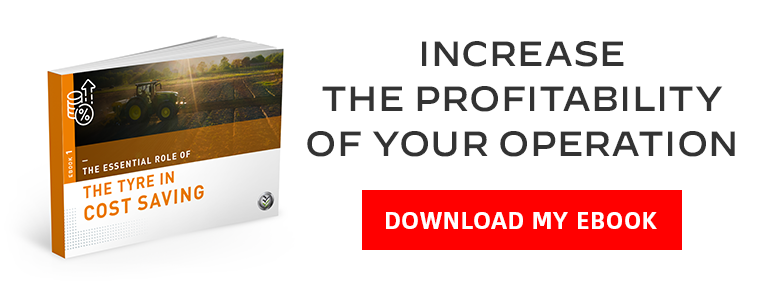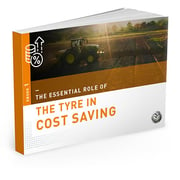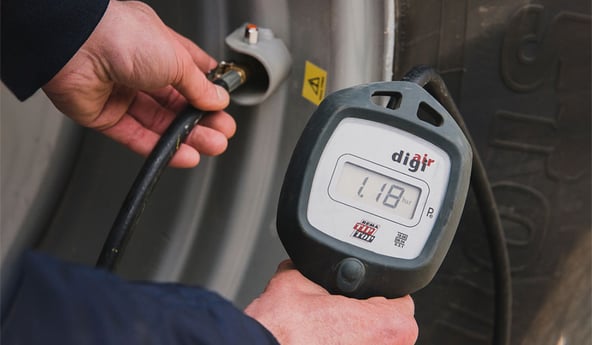The calculation of the load transfer to your agricultural tyres is absolutely vital to ensure that your equipment performs well and to preserve soil quality. Poor management of load and too much load transfer to the axles can cause major problems: soil compaction, slippage, premature tyre wear and damage.
For farmers, too much load not only compromises the efficiency of operations, it also leads to additional expenses such as extra fuel costs, rapid wear to your equipment and more frequent replacement of your tyres.
This article explains how to calculate the load carried by your tyres, the importance of the load transfer and how to take it into account when using your implements. We will also look at practical solutions, including the use of low pressure tyres, to help you optimise settings and improve the profitability of your farm. Let’s move from theory to practice to get the most from your equipment.
1. Problems linked to excess load on agricultural tyres
Tyre damage and rapid tyre wear
There are multiple possible consequences if you overload the structure of your tyres, and this may prove costly in the long run.
Irreversible distortion
An excessive load makes it necessary to increase the pressure in your tyres to compensate for the extra weight. If the increase in pressure is not enough, this leads to an excessive distortion of the sidewalls and casing of the tyre.
The tyre components are pushed beyond their limits which can lead to structural weaknesses or even total rupture.
Accelerated wear
Too much load or an unevenly distributed load cause premature tyre wear. Crushed by the weight, the lugs wear more rapidly, the sidewalls become misshapen and the casing weakens.
Inappropriate ballast
Too much ballast or imbalanced ballast can worsen the problems. This creates additional strain on the tyres, leading to premature wear and increasing the risk of distortion.
In addition, incorrect balance between the ballast and the attachment can lead to variations in load transfer which also accelerate damage to the tyres.

Soil compaction, loss of traction and slip
In addition, overloading tyres has direct consequences on soil quality and tractor performance in the fields.
Soil compaction
An overloaded tyre exerts too much pressure on the soil, compacting it and reducing its porosity. Plant roots find it difficult to penetrate, which limits their development and affects your yield.
Loss of traction
A heavy load means that you have to increase pressure to compensate, which limits the size of the tyre footprint and grip, thus reducing your tractor’s traction capacity, especially in wet conditions or on sloping land.
Slip
Too much load or unsuitable pressure settings increase rolling resistance, create deep ruts and encourage wheel slip.
This accelerates tyre wear and increases the production costs linked to frequent replacement of your equipment.

2. How to calculate the load on your tyres
The principles of load calculation
Calculating the load borne by the tyres of an agricultural vehicle consists in determining the vertical force applied to each of them. This force takes several factors into account:
- The weight of the vehicle: the weight of the tractor itself or the self-propelled machine constitutes the basis for the calculation of the load.
- The load transported: the weight of the implement (seeder, plough, etc.) and its payload (seed, fertiliser) which is added to the weight of the vehicle.
- The weight distribution: the weight is not distributed evenly between all the axles. The load transfer, that is to say the transfer of the weight from one axle to another depending on the position of the implements or the ballast, plays a crucial role.

Tools and calculation methods
To calculate the load borne by your tyres and define the right pressure, several tools are available to you:
- Weighing tools: scales are the most precise tools for measuring the load on each axle. Either you have your own or you can use the scales belonging to your agricultural cooperative.
- Weigh pads: equipped with captors, these allow you to measure the pressure exerted by each tyre on the ground and to obtain a precise indication of the load.

- Online calculators: many online applications allow you to make simple and rapid calculations of pressure based on load.
- Manufacturer load charts: manufacturers often provide charts which you can use to estimate the pressure for each tyre based on the load calculated.
The load can be calculated simply by adding up the weight of the vehicle, the implements, the ballast and the payload, then spreading this total load over the different axles depending on their position.

- M1: The weight of the front ballast or the front implement.
- M2: The weight of the rear mounted implement.
- d1: Distance between the middle of the front ballast and the centre of the front axle.
- E: Distance between the middle of the front axle and the middle of the rear axle.
- d2: Distance between the middle of the rear axle and the middle of the rear mounted implement.
- Weight of the front axle: Manufacturer data
- Weight of the rear axle: Manufacturer data
When you have found all the weight related information in the manufacturer data and you have taken your measurements, you can make the calculation as follows:

Like for the calculation with weighing equipment, you can check that the end weight obtained is in line with the load index indicated on each tyre.
You will then be able to adjust pressure based on the load and the intended travel speed.
Adapting tyre pressure to the load
Tyre pressure must be adapted to the actual load, to the working conditions and to travel speed by road. Insufficient pressure compared to the load leads to an excessive distortion of the tyre and premature wear, whereas too much pressure increases rolling resistance and encourages soil compaction.
3. Load transfer: from theory to practice
What is load transfer?
Load transfer is what occurs physically when an agricultural vehicle is equipped with implements or additional weights.
It consists in the redistribution of the weight of these elements between the different tractor axles. In other words, the load transfer describes how the weight of an implement, a tool or a payload or ballast influences the pressure exerted on each tyre.

to the rear axle of the tractor
Good management of the load transfer is essential to optimise tractor performance. By spreading the weight in a balanced way, it is possible:
- To improve traction: by spreading out the weight optimally, you ensure better adherence to the ground for the 4 tyres which work together in a balanced way, which improves traction, especially in difficult conditions.
- To limit soil compaction: a balanced distribution of weight makes it possible to reduce the pressure exerted on the ground by each tyre, thus limiting compaction and protecting the soil structure.
- To limit tyre wear: by avoiding overloading the tyres, you extend their useful life, reduce maintenance costs and avoid overly frequent tyre replacements.
Practical implementation in the field
For a practical illustration of the calculation of the load transfer, here is an example corresponding to the preceding formula:

John Deere 6250 R tractor – Drive ratio: 1.328
Tyres:
- Front: 600/70 R 30 TM900 HP 158 D – Rolling circumference = 4820 mm
- Rear: 710/70 R 42 TM900 HP 173 D – Rolling circumference = 6190 mm
- Lead = 3.408 %
Mass for each element:
- Tractor: Front axle 3,860 kg - Rear axle 5,790 kg
- Front mass: 1,200 kg
- Combined rear implement harrow/seeder: 3,500 kg
i.e. total weight to the ground,
not coupled to the tractor: 14,350 kg

Calculation of load:

Same calculation with real data:
FRONT load = 1,200 kg × (1300 + 2900) + 3,860 kg = 5,598 kg
2900
REAR load = 3,500 kg × (2700 + 2900) + 5,790 kg = 12,548 kg
2900
Total weight with load transfer = 18,146 kg
Pressure settings:
Front: 600/70 R 30 = 1.2 bar at 40 km/h
or 1.0 bar at 10 km/h
Rear: 710/70 R 42 = 1.6 bar at 40 km/h
or 1.4 bar at 20 km/h
4. Solutions and advice for reducing the impact of the load
Choose the right tyres to limit compaction
The choice of tyres is an essential step in reducing the impact of the load to the ground. VF (Very High Flexion) tyres represent a significant breakthrough in this domain.

Why choose Bridgestone’s VF tyres?
Thanks to their reinforced internal structure, VF VT-TRACTOR tyres can carry 40% more load compared to standard tyres, while maintaining a low inflation pressure. This feature makes it possible:
- To spread the load over a larger surface area on the ground: VF tyres flatten out more in contact with the ground, which increases their contact patch and reduces the pressure exerted on each square centimetre.
- Limit compaction: by reducing the pressure to the ground, VF tyres minimise soil compaction, thus preserving the soil’s structure and fertility.
- Improve traction: the larger contact patch with the ground offered by VF tyres increases the number of lugs that simultaneous grip into the ground, thus improving traction, even in difficult conditions.
To optimise the capacities of your VF tyres, especially if you make a lot of trips by road and cover long distances, you can use a central tyre inflation system which will be particularly useful.
This allows you to adapt pressure depending on the load, but also based on travel speed on the road.
Adjust pressure based on external conditions
In addition to adjusting pressure based on your load, as advised by your tyre manufacturer, you should adapt to your environment and slightly increase or decrease pressure so that your settings correspond perfectly to your specific situation.
Some advice:
- Adapt pressure to soil conditions: on hard, dry soil, slightly higher pressure may be necessary to improve stability. On the other hand, on soft, damp soil, a slightly lower inflation pressure will help reduce compaction.
- Make your own pressure table: create a table listing the different machine configurations on your farm with all your implements to establish the corresponding pressure in each case. This will save you time and just require a quick pressure adjustment based on your table before starting each operation.
CONCLUSION
Optimal management of load transfer to agricultural tyres is essential if you wish to preserve your tyres and your soil.
Using suitable tyres, such as the VT-TRACTOR tyre, makes it possible to work with more load while reducing compaction, increasing traction and decreasing operating costs.
By adjusting pressure correctly based on the load and adopting targeted agronomic practices, you will be able to get the most from your equipment.
Putting theory into practice in the management of load transfer is a worthwhile investment, from both an economic and an environmental standpoint.
The Bridgestone-agriculture.eu blog is written and administered by tractor tyre experts who are available to provide you with the advice that you need about your farming tyres. They will help you to maximise your productivity with information on all things relating to tyres: inexpensive tractor tyres - technical data for farming tyres - advice on farming tyre pressure - solution to avoid soil compaction - sprayer tyre pressure - Why and how to ballast your tractor tyres - when to use twin wheels - the mechanical causes of abnormal wear - cheap agricultural tyres - etc.
To take it a step further and increase the profitability of your farm, the tractor tyre experts has prepared a free, highly detailed, ebook which explains the essential role of farming tyres on your productivity.
Most people who read this article have also read some of the following articles:
- 12 simple tips to better manage the pressure of your agricultural tyres
- 7 advantages of low-pressure tyres compared to normal tyres
- What is the right inflation pressure for any tractor tyre
- The keys to working at very low pressure with your agricultural tyres
- Understanding your tractor tyres’ pressure -load -speed link
- Tank Air Wheel rims, to inflate tyres in 1 minute
- Can you go beyond the recommended pressure for your tractor tyres?
- Opt for a harvest campaign with low-pressure tyres
- 11 keys for knowing everything about agricultural tyre pressure
- How agricultural tyre pressure affects your efficiency
This information is intended only to make you aware of the technical and functional aspects of agricultural tires and their use. It does not allow you to make a judgment or a definitive conclusion on a given problem. Only your agricultural tire expert is able to make a technical assessment and take a final decision, case by case.
Leave a
commentary
Your email address will not be published.
Required fields are indicated with *








